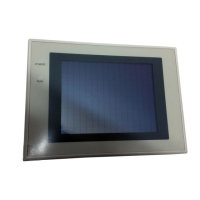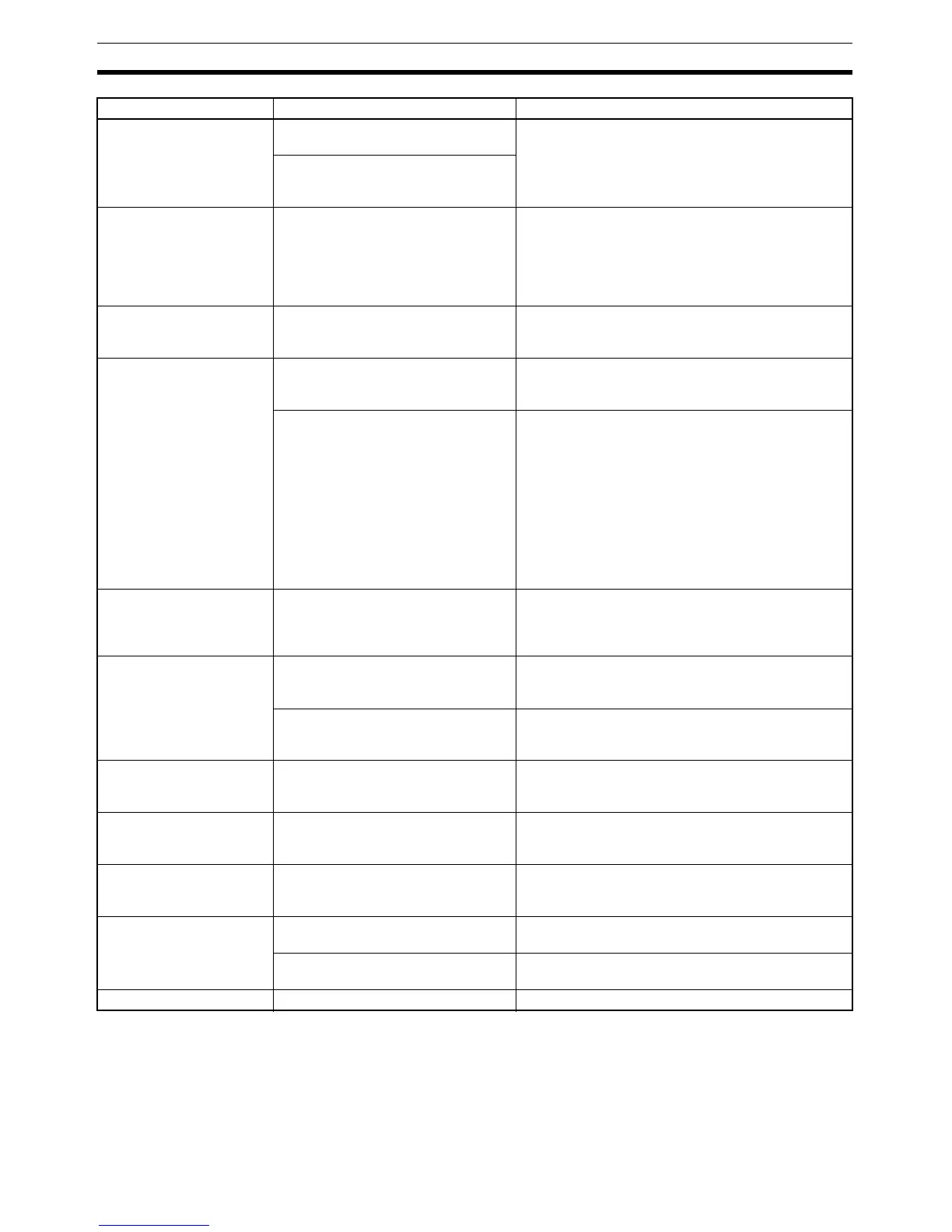234
Troubleshooting Section 7-1
Some of the elements
arranged on a normal
screen are not displayed.
The quantity of read data exceeds the
stipulated restriction.
Check the maximum number of elements by referring
to Display Restrictions in Appendix A of the Refer-
ence Manual. Create the screen data again and then
transmit all of the screen data in a batch to the NT31/
NT31C.
The total of the element coefficients
for the displayed screen is greater
than 1024.
On an overlapping screen,
some of the set elements
are not displayed.
Since the data is transmitted from the
host in screen units, the number of
elements on the overlapping screen
has exceeded the maximum permis-
sible without being checked by the
Support Tool.
Check the maximum number of elements by referring
to Display Restrictions in Appendix A of the Refer-
ence Manual. Create the screen data again and then
send all the screen data in a batch to the NT31/
NT31C.
The System Menu cannot
be called up.
Display System Menu under Change
System Settings in the System
Installer mode is set to Disabled.
In the System Installer mode, set Display System
Menu to Enabled (page 153).
The following System
Menu operations are not
possible.
-Establishing the Transmit
mode
-Displaying the memory
switch setting screens
-Screen data memory
check
-Displaying the initializa-
tion menu
-Displaying the calendar/
time setting screen
Screen Memory Protect under
Change System Setting in the Sys-
tem Installer mode is set to Disabled.
In the System Installer mode, set Screen Memory
Protect to Enabled (page 153).
Screen Memory Protect has been set
to Disabled because the PT power
supply was turned OFF during dele-
tion of screen data.
Do not turn the PT power OFF during deletion of
screen data.
In the System Installer mode, first change the setting
for Screen Memory Protect to Enabled, then repeat
the screen data delete operation (pages 153 and
154)
Cannot input numeric val-
ues
The upper/lower (max./min.) limit
check for numeric value input is in
effect.
Check the screen data’s upper/lower (max./min.) limit
check setting for numeric value input, and correct it if
necessary. Refer to 2-12 Inputting Numeric Values in
the Reference Manual for details.
Cannot input numeric val-
ues/character strings.
Bit 5 of the PT status control area
(numeral/character string input) is set
to 1 (ON).
Set bit 5 to 0 (OFF). Refer to 2-2-1 PT Status Control
Area (Host ↔ PT) in the Reference Manual for
details.
The interlock function is set for the
input field and the controlling interlock
bit is OFF.
Inputs are prohibited in input fields when the corre-
sponding interlock bit is OFF. Check the status of the
corresponding interlock bit and turn it ON.
Window screen does not
open
Bit 6 of the PT status control area (PT
window opening) is set to 1 (ON).
Set bit 6 to 0 (OFF). Refer to 2-2-1 PT Status Control
Area (Host ↔ PT) in the Reference Manual for
details.
Cannot switch screens
with touch switches
Bit 4 of the PT status control area (PT
screen switching) is set to 1 (ON).
Set bit 4 to 0 (OFF). Refer to 2-2-1 PT Status Control
Area (Host ↔ PT) in the Reference Manual for
details.
Touch switch does not
work. (Buzzer sounds.)
The interlock function is set for the
touch switch and the controlling inter-
lock bit is OFF.
Touch switches are disabled when the corresponding
interlock bit is OFF. Check the status of the corre-
sponding interlock bit and turn it ON.
The display is dim. Insufficient contrast or brightness Increase the contrast/brightness (pages 191 and
193).
Backlight defective, or its life has
expired
Replace the backlight (page 241).
The display is too faint. The contrast is too high. Reduce the contrast (page 191).
NT31/NT31C Symptoms Cause Remedy

